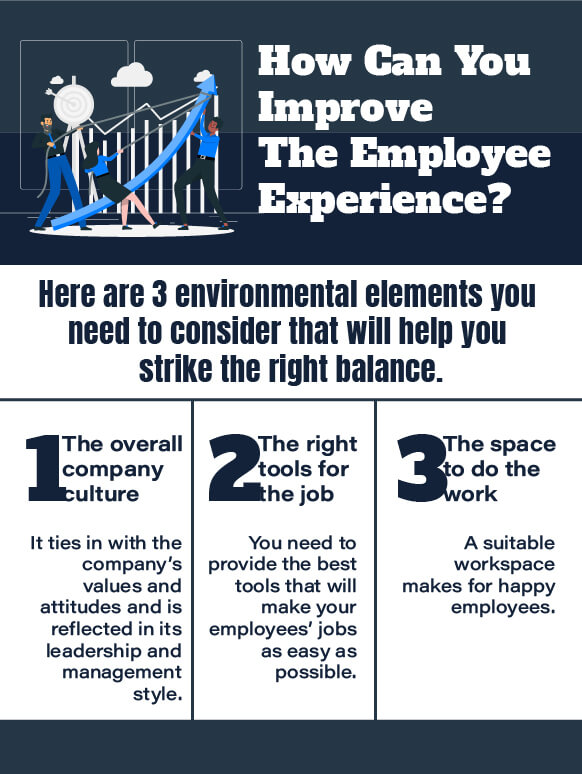Last updated: 26 January 2022

The workplace as you know it has altered dramatically in the past 2 years.
It’s been evolving steadily thanks to the growing quantity and variety of online roles.
This steady growth would no doubt have continued had it not been for one global life-changing event.
The COVID-19 pandemic.
Suddenly whole companies practically emptied their offices and encouraged people to do their work from home.
This has led to a serious change in the way employees perform and respond, what experts are now referring to as employee experience or EX.
But what is employee experience?
It doesn’t mean the amount of experience an employee might have or that he or she might bring to a post.
It relates to the way employees experience their time within an organization, from start to finish.
And because the organizations themselves have had to adapt and change to navigate their way through the coronavirus crisis, it has become all too apparent that the employee experience also needs to change.
Not just for the sake of the employees, but also for the longevity and survival of the companies.
But why should that be?
In other words, what is employee experience and why has it become such a crucial driving force?
What Is Employee Experience?
A lot has changed in the last 24 months.

Organizations are discovering how much the office environment affected company culture and influenced everything from employee recruitment to retention.
The hybrid working environment is likely to continue, with employees spending more and more time outside the office.
According to an article , EX refers to everything your worker experiences, from the moment they read the job opening to the time they leave the company.
They list 5 stages that might be highlighted as part of the employee experience, which are summarized below:

Recruitment
This includes the whole recruitment experience, from listing the job to interviewing and choosing the most suitable candidate.
Onboarding
This refers to how quickly new employees can get up to speed with their role and the tasks they have to perform. The quicker the better in terms of company profitability.
Development
This involves giving staff the chance to develop their skills, work towards promotions and possibly take on leadership roles through appropriate training opportunities.
Retention
Once staff are fully integrated, it makes sense to keep them within the company where they can contribute to its growth and development. Replacing seasoned workers can be expensive and time-consuming.
Exit
People leave for different reasons, but getting them to tell you why can help improve the EX for the staff that remain.
Everything an employee sees, does, feels and learns is part of their employee experience. In order to excel at EX management, organizations need to listen carefully to what their staff are telling them at every stage of the EX lifecycle and create bespoke experiences.
Companies are beginning to realize that employees are the lifeblood of their organization. The more invested they are in the work that they do, the more effort and enthusiasm they’ll put into it.
As the folks at Gallup explain, employees are “consumers of the workplace.” They also point out some statistics gathered from staff teams regarding their particular employee experiences:
- The number 1 reason why people change jobs is to get more career development opportunities
- Only 12% of employees think their company does a good job of onboarding
- Only 1 in 5 of employees feel that their management team motivates them to do a good job
If the pandemic has taught businesses anything, it’s the fact that they need to be flexible and able to adapt. And with the rise of the remote work culture, the idea of creating a positive and engaging employee experience has become an essential consideration.
Why Modern Organizations See EX As A Trend
Is EX just another one of those leadership trends, a mere flash in the pan, or does it represent the next stage on the evolutionary business ladder?
It looks like the future of business depends on it, in the short term at least, for a number of reasons:
1. Companies are growing and shrinking faster than ever, and they need to be in step with how this affects their staff teams
2. The millennial generation wants more from a job than their predecessors, including the ability to work for someone who understands them and their needs
3. There are fewer jobs and more candidates, so the EX is a way for employers to stand out and get the best talent
4. Workplaces have become more transparent because of the potential for social media reviews to damage their reputation
5. Employees expect a more individual experience just like they get when they interact as consumers with other companies online
Businesses that have focused on improving their employee experience point out improvements in turnover rates and absenteeism, customer satisfaction and profitability.
So what can you do to improve the EX in your company?
How Can You Improve The Employee Experience?

Most approaches advocate integrating all of your business practices to provide the best and most comprehensive employee experience. Before you tackle that challenge, however, you need to know exactly how the EX manifests itself in your organization.

With these components in place, an article at Deloitte suggests several steps you can take to improve the employee experience from start to finish.
- Make EX a priority – develop a process that integrates the work, the workplace and the experience of the staff team, not forgetting to include employee well-being.
- Make someone responsible – the integrated employee experience will include employee engagement, development, performance, and rewards, so it might help to assign a senior HR manager to organize and implement EX.
- Listen and learn – talk to and listen to your staff so you can understand their daily routines in terms of performance, productivity and engagement.
- Involve the whole workforce – the employee experience should be able to engage all members of the workforce, whether they are full-time, part-time, freelance, or casual staff.
- Enlist top-level help and support – team leaders and top brass should engage with staff on a daily basis to set the tone and culture, which will also make it easier for them to audit performance and consider rewards for outstanding work.
- Learn from others – visit other companies with a good employee experience program to get tips that will help fill any gaps in your organization’s model.
- Measure the results – use regular feedback and ongoing performance reviews to find out what issues your employees are dealing with and how their EX can be improved to make things work more smoothly and productively.
Why Is EX The Key To Organizational Growth?
The nature of work is changing. Many major organizations understand the value of EX to inspire their employees to achieve greater things, leading to employee loyalty and better retention levels.
On their blog, McKinsey offers a valid explanation. There’s so much amazing technology available these days that a lot of the work is going to become automated. That will naturally influence the way people interact with companies.
To recruit the best talent, businesses will need to offer employees a more exciting and comprehensive all-round package.
It’s thought that the winners in the talent war will be those with the best employee experience program.
The simple truth is that employers need to provide an engaging experience if they hope to hire and retain the most suitable candidates. As the folks at McKinsey see it, they need to “create personalized, authentic experiences” that will ultimately “strengthen individual, team, and company performance.”
And while traditionally it was up to the HR department to address engagement, rewards, career development and so on, the growing focus on getting the employee experience right has to involve all levels of management and leadership.
One of the reasons why EX is becoming such a crucial factor is down to employees themselves. In today’s job marketplace candidates are choosy about who they decide to work for.
They size up a company from the get-go, even from the way the post is advertised. The whole recruitment process lets them get a feel for how things are run and how their work will slot into the rest of their life, including emotional, physical and financial considerations.
Current thinking is for a more holistic approach to the employee experience, one that gives members of staff a more satisfying and engaging work environment. That also means that any organizations who fail to rise to the challenge will ultimately be left behind.
Conclusion & Key Takeaways
There have been some dramatic changes to the workplace in the past 2 years thanks to the COVID-19 pandemic.
This has led to a serious change in the way employees perform and respond, what experts are now referring to as employee experience or EX.
EX is the way an employee experiences his time within a company, from start to finish.
There are reportedly 5 stages within the EX process, which are:
1. Recruitment – including the whole recruitment experience
2. Onboarding – how quickly new employees can get up to speed with their role
3. Development – giving staff the chance to develop their skills and progress
4. Retention – keeping trained staff within the company
5. Exit – finding out why people leave
Employees are the lifeblood of any organization, so companies need to listen to their staff and create bespoke employee experiences.
The more invested employees are in their work, the more effort and enthusiasm they’ll put into it.
EX represents a way for employers to stand out in the workplace and attract the best talent for their businesses.
You can improve your EX by making sure employees have access to:
1. A positive and motivating company culture
2. The right tools for the job
3. The appropriate space to do their work
As well as engaging all workers at all levels, the EX should be measured regularly to find out what is and isn’t working. This will improve the overall experience and will make the working environment run more smoothly and productively.
It’s been suggested that a more holistic approach is needed to give employees a more satisfying and engaging work experience. Companies that fail to provide this will ultimately find themselves left behind.

